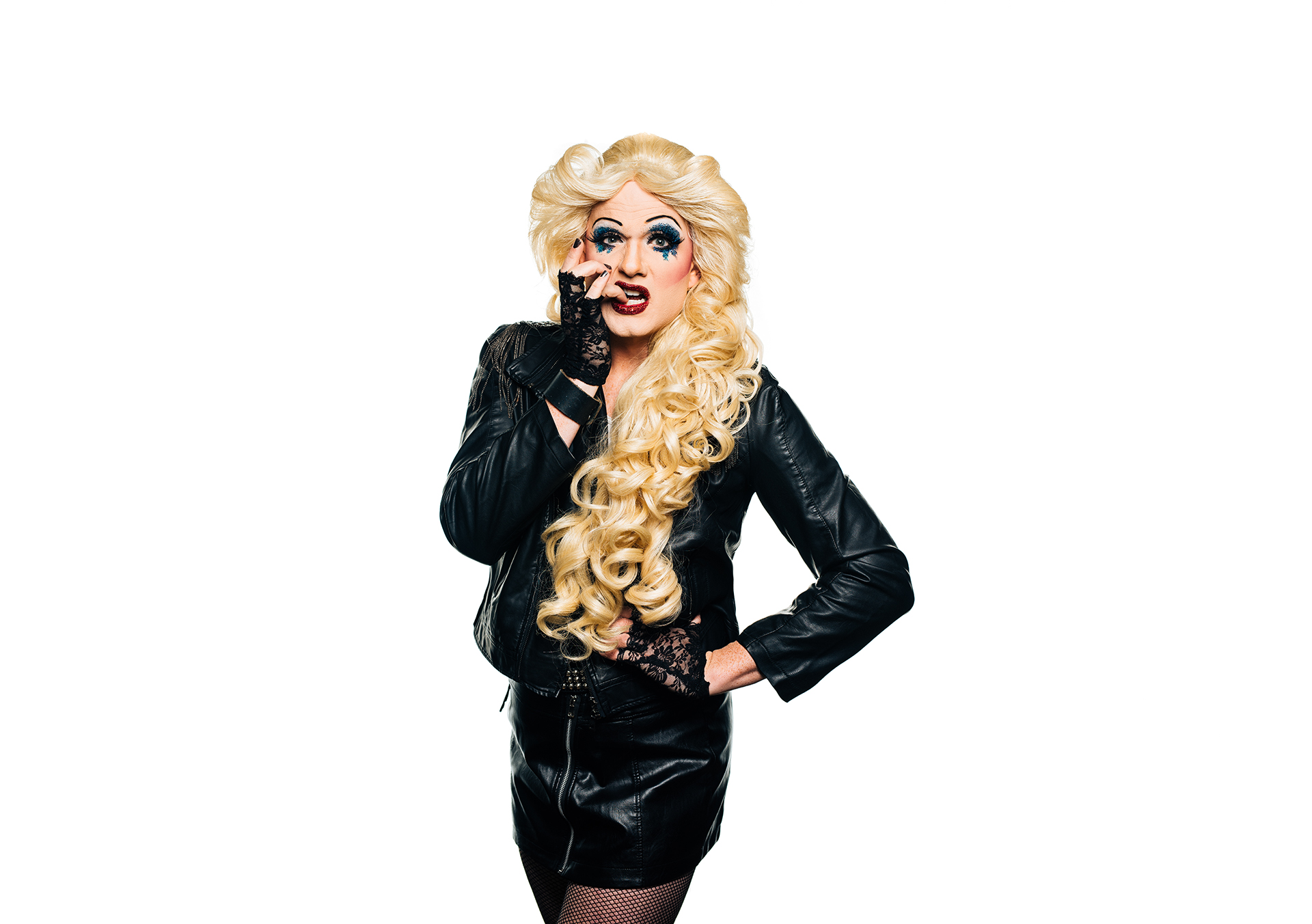This Sandy Staggs interview was originally published by Carolina Curtain Call on February 26th, 2020. Image by Will Crooks.
“Delighted Tobehere lives in a closet in my apartment, and more often than not, in a suitcase,” reveals Clay Smith of his alter ego best known as that drag queen from Greenville who resoundingly shocked and charmed America’s Got Talent judges and audiences as the 7-foot beauty that started her performance in operatic soprano and then lunged into country basso with Josh Turner’s’ “Your Man.”
Upstate fans may know Delighted from her sell-out Drag Brunch shows at Cafe And then Some, now in its third year.
And beginning February 28, Delighted will forever known by “Hedheads” as Hedwig the gender queer punk-rocker in The Warehouse Theatre’s musical this season Hedwig and the Angry Inch about an East German youth who falls in love with an American soldier and ends up a bitter ex-rocker in a Midwest trailer park.
“I have not worked this hard in a long time,” Delighted admits of the grueling Hedwig rehearsals. She has thrived for the last 12 years exclusively as a professional popular entertainer who can now live comfortably in New York City on just two or three gigs a month.
Previously serving as hair and makeup artist for two versions of Hedwig at the Actor’s Theatre of Charlotte, the second one starring Scott Ripley, brother of Tony-winner Alice Ripley, Delighted has also seen two Broadway productions with Hedwig creator John Cameron Mitchell.
“This is a deeper production that I have ever seen,” Delighted says after digging into the script by Stephen Trask and John Cameron Mitchell with director Andrew Scoville (BLOODY BLOODY Andrew Jackson) and co-star Miranda Barnett who plays Yitzhak. “I think about Hedwig in so many ways. It’s so tragic.”
When asked to elaborate on “The Angry Inch” from the show’s title, Delighted replies ever so quickly and coy: “It’s Hedwig’s band. What the audience is gong to experience is a rock concert.”
“The Angry Inch” as HedHeads already know is also Hedwig’s act of sacrifice to escape the Iron Curtain.
Delighted also wants to clear one misconception audiences often have of Hedwig: “I think its important to stress that Hedwig is not a drag queen.
In a big moment of discovery for Delighted and the Hedwig team, Hedwig, they determined, “is gender queer and a gay man who is determined to do anything to get out of a terrible situation.”
“This is an example of gender identity but in the context of a mask. It’s a charming disguise and the show is really engaged in that journey for self-acceptance and living authentically,” Delighted adds.
“The message of the show is about the acceptance of self and the love of others,” she says. “It’s a show that talks a lot about community, conflict, heartbreak, and anger and desperation. But its still a very funny show!”
Delighted is now celebrating her 19th anniversary (February 22) as a drag illusionist and entertainer, and that does not include a stint in the drag camp comedy troupe, The Armorettes (after the famed San Francisco Cockettes). Delighted fondly recalls the shenanigans and sketches the queens did with goatees and hairy chests all in the name of raising funds for HIV charities.
But Delighted’s more recent fans may know realize that she is only 5 years old.
Until 2015, Clay Smith was better known as Roxy C. Moorecox, the popular performer and emcee at local and regional Pride events.
“That was a very big year for me. I became sober from alcohol.”
And in that clarity, Clay found a new attitude and lost 70 pounds. “I realized a re-branding needed to take place.”
Hence, Delighted Tobehere, a new name that reflected a more positive outlook on life. And a name that could be repeated in front of children … and on prime time television.
“Roxy C. Moorecox,” Delighted concurs would have never made the cut for America’s Got Talent.
“There can be a lot of negativity in drag – insult comics and such – I wanted to be something different,” says Delighted, who imparts an abundance of clean humor in her shows.
Delighted also sets herself apart by using her own voice instead of lipsyncing as the vast majority of drag queen do. Delighted is Clemson University vpice major grad and holds the distinction as the only Clemson alum to come back and perform a solo show at the Brooks Center for the Performing Arts – her one woman edutainment cabaret DRAG 101.
But having lipsynced exclusively for more than half of her career, Delighted was quick to knock anyone who says lipsyncing is easy, especially bravura lipsyncing.
“There is a skill and art form to it,” she says.
While one won’t see Delighted perform cartwheels and splits, a move often landed on RuPaul’s Drag Race during the “Lipsync for Your Life” battle, she lauds those than can.
“Basically I can’t do splits,” she told QNotes magazine in 2015. “If I tried to do a split, I would just be grateful for Obamacare. My sisters that can deserve every dollar that is rained on them for doing so too.”
Delighted and her sisters in the industry have benefited from the RuPaul phenomenon, allowing drag culture to spread from after-hours gay clubs and Pride festivals, to more mainstream venues like libraries, restaurants and comedy clubs.
When I mention that only a few years ago, seeing a drag queen in public in broad daylight and before midnight (unless it was a Pride event) would have been unheard, Delighted, with a hearty chuckle, proudly chimes right in with her drag brunch slogan: “Drag in the daytime in Greenville.”
“There’s more to it than a man wearing heels. It’s a dynamic art form,” says Delighted. “People can find hope and courage to be who they want to be.”
“If you were a shy person and you do drag, you find that that wig allows you to perform, and be funny and maybe even have the courage to talk to someone who is attractive. And when you take that wig off, you discover that that person was really you all along.”
But despite these momentous advances culturally, “We are still a discriminated group,” Delighted adds. “The ignorance of the [general] community persists for drags queens and transgender persons.”
“Drag people are some of the strongest folks I know and stand up to diversity,” she says.” Drag queens have been the bullhorns in the movement, it was people of color, transgender, and drag queens that fought at Stonewall.”
“Understanding is not a prerequisite for respect. The first step for respect is education and acceptance. If we can respect each other, that can be a great start.”
The Warehouse will also continue its tradition of community forums related to the current show with a program “Understanding Southern Drag Culture” on Wednesday, Feb 26 at 6:30 p.m., and “Trans 101” on Saturday, Feb. 29 @ 6:30 p.m.
I asked Delighted how Southern drag differs from the artform in other parts of the country, but she quickly retorted that I had asked the wrong question, which should have been, “How does drag in Georgia differ from Greenville drag, or South Carolina drag to North Carolina drag?”
“I have been fortunate to perform around the world and have seen the fabulous nuances in drag everywhere,” she says.
But in general, Delighted said that in the South, “pageants are influential and bigger hair and spectacular costumes are the norm. In the North, there are more Broadway/entertainment performers and comedy queens; and the West Coast is a combination of the two.
For the month-long run of the show, the lobby has been transformed into the first-ever Drag Museum, celebrating the history of drag in Greenville.
Follow @QueenDelighted on Facebook, Instagram, Twitter, YouTube, and at imdelightedtobehere.com.




